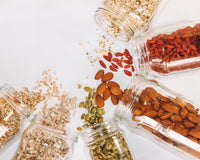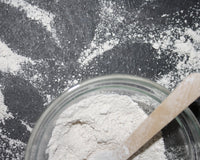Everyone knows that seeds are one of the healthiest ingredients you can incorporate
into your diet, but people often underestimate exactly how significant their health
benefits can be. Each seed looks and tastes different, so it shouldn’t be any surprise
that their nutritional profiles are just as diverse. In this article we’ll break down some
of the best seeds you can include in your diet, as well as how you could cook with
them. It’s also important to note that we can’t mention every single type of seed here,
so don’t be afraid to venture outside of this list and really experiment in the world of
seeds.
Chia Seeds
Organic chia seeds are one of the world's most popular superfoods, so it makes sense that
they’d be on this list. Chia seeds are small edible seeds from the mint family
originating from South America, where they have been cultivated dating all the way
back to the Aztec Empire.
Chia seeds are unique mainly because of their status as a complete protein, meaning
they contain all nine essential amino acids that the body needs but cannot produce
on its own. Complete proteins can be quite hard to find outside of animal sources, so
chia seeds are naturally a great choice for vegans or those on plant based diets. Chia
seeds are also incredibly high in fibre, with just two tablespoons providing nearly 10
grams of dietary fibre. Being high in fibre means that chia seeds are a great way to
improve digestion, but crucially also heart health. As chia seeds reduce the amount of
bad cholesterol in our bodies, they simultaneously increase the amount of good
cholesterol that lowers the risk of heart disease.
How to use chia seeds:
Chia seeds are fairly versatile, but they are most commonly used in drinks, puddings
and salads. There is significant debate (particularly amongst healthy eaters) as to
whether it is best to soak chia seeds before eating them or not, but really it depends
on personal preference. While soaking chia seeds can make them more easily
digestible, and therefore slightly more nutritious, it also removes their crunchy
texture. If you’re making chia pudding or looking to bulk out a smoothie then it’s
best to soak your chia seeds, but if you’re looking to use them to add some extra
texture to a salad then you’re better off simply sprinkling them on top.
Flaxseed/Linseed
Flaxseed (also known as linseed) comes in two varieties, gold and brown, and while
they have pretty much identical nutritional profiles, golden flaxseed has a slightly
richer taste. Flaxseed is a severely underrated ingredient, and really should be
considered a superfood in its own right, rich in protein, fibre and omega 3 fatty acids,
it is a great all rounder. Crucially flaxseed is both gluten free and vegan, which makes
it a must have for either of those diets, primarily for its high protein and linoleic acid
content. Linoleic acid is a type of omega six fatty acid, which can be incredibly
difficult to find outside of oily fish, not only is it great for maintaining healthy skin,
but also for lowering cholesterol and improving insulin sensitivity.
How to use flaxseed
Flaxseed has a very subtle flavour, so it can easily be paired with sweet or savoury
recipes, or simply mixed with water and enjoyed on its own. However it is important
to increase your water intake as you begin to incorporate flaxseed into your diet to
avoid dehydration and digestive issues.
Pumpkin seeds
Organic pumpkin seeds are a great way to boost the nutrition of your diet without too much
hassle, they can be enjoyed as a snack on their own, or sprinkled into salads, soups
and curries. Pumpkin seeds are not only convenient, but also highly nutritious. Like
chia seeds and flaxseed, pumpkin seeds are rich in healthy fatty acids, protein and
vitamin E. Vitamin E is tremendously important to the development of healthy
skin, hair and most importantly eyesight.
Pumpkin seeds also contain an abundance of antioxidants, and have been found to
improve heart health, as well as potentially lowering the risk of cancer while also
improving bladder health.
Sesame seeds are a pretty common household ingredient, but their staggering
nutritional content and health benefits are often forgotten. Typically a staple in Asian
and South American cooking, sesame seeds have a mild slightly sweet flavour, and are
great in both sweet and savoury cooking. Sesame seeds have a lot of benefits in
common with the seeds we’ve already discussed (primarily omega fatty acids and
vitamin E), but they are unique in having an exceptionally high amount of zinc.
Zinc may not sound like an important nutrient for the body, but that couldn’t be
further from the truth. Zinc plays a vital role in the immune system, wound healing,
and even protein synthesis, so it is incredibly important to make sure your body gets
enough of it.
How to use sesame seeds
Sesame seeds can be sprinkled into savoury dishes, either raw or toasted, and it’s
subtle sweet flavour works particularly well in Asian dishes, but they can also be used
to make tahini. Tahini is a type of paste traditionally used in Middle Eastern cuisine,
acting as a base for dips like hummus and baba ganoush, or used in baking to
improve a dish’s nutritional content, and add a natural sweetness.
Why you should start making seeds a part of your daily diet:
The health benefits we’ve outlined above should already peak the interest of anyone
looking to live a healthier life, but also for anyone seeking new recipes, flavours and
culinary adventures. Not only does each type of seed have a different health benefit,
they also all have a wide multitude of uses, and can really help make your cooking
more varied than it ever has been before. Once you start using seeds in your recipes
you’ll find it hard to stop, whether you’re looking to add some texture to a dish or
drink, or simply trying to bring out some rich (but healthy) flavours, seeds can do it
all.






